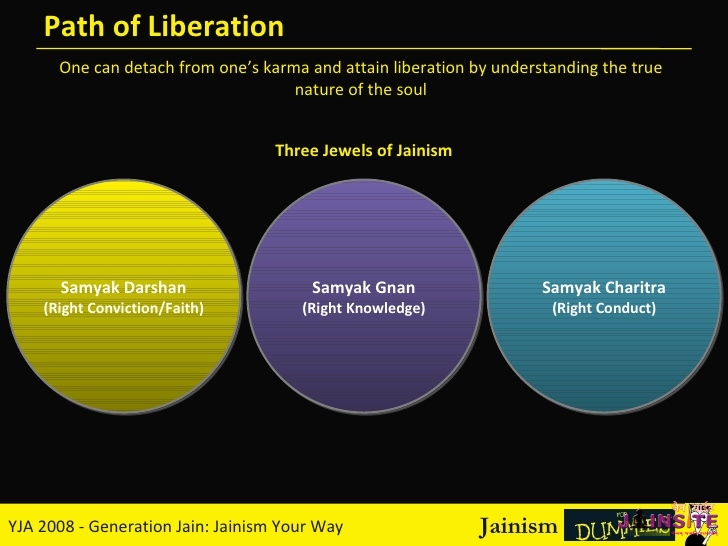Chapter 12 – Path of Liberation – Three Jewels
The ultimate goal of all life and conduct in Jainism is to realize the free and blissful state of our true being. True philosophy should result in removing all bondage (karma) in the process of purifying the soul.
The central theme of Jainism considers religion as a science of ethical practice. The conduct of the present life should be aimed to attain liberation (Moksha), the state of eternal bliss from which there is no return to the cycle of life and death. Every soul can attain liberation and a supreme spiritual state by realizing its intrinsic purity and perfection.
Jainism lays down a definitive course of practical moral discipline, contemplation of the highest truth, and reorientation of life for attaining ultimate reality or truth. Lord Mahävir and the other Tirthankars have shown the effectiveness of spiritual progress by putting it into the practice in their own lives. The prominent Monk, Umäsväti, around the 1st or 2nd century A.D., reminded us of it again in the very first verse of his Tattvärtha Sutra. It reads:
“Samyag-darshan-jnän-chäriträni Mokshamärgah”.
This prescribes a path to liberation (Moksha), which consists of the following trinity (Ratna-Traya):
- Right perception Samyag Darshan
- Right knowledge Samyag Jnan
- Right conduct Samyag Charita
Right perception creates an awareness of reality or truth, right knowledge impels the person to proper action, and proper conduct leads him to the attainment of total freedom. They must coexist in a person if one is to make any progress on the path of liberation.
Right Perception or Faith (Samyag Darshan)
The first step in the process of self realization is to discard superstitious beliefs and to adopt a rational attitude in life.
Right perception consists of seeing the true nature of every substance in the universe. Jainism advocates that one should first try to know, comprehend, and understand the nature of reality, one’s own self, religious goal, and the path. One should analyze, examine, test, verify, and then, if satisfied, be convinced of its truth and efficacy.
From a practical point of view, perception in the nature of the reality means to have a total faith in the preaching of Tirthankars and their scriptures, known as Ägams.
Right Knowledge (Samyag Jnän)
Right perception or faith makes us realize the reality of life, and the seriousness of our purpose in life.
Right knowledge is the true, correct, proper, and relevant knowledge of the reality. To understand reality, one should know the fundamental elements of the universe and their relationships.
From the practical point of view, right knowledge means the proper knowledge of the six universal substances and nine principles or Nine Tattvas. Which defines the relationship between Soul and Karma.
Six Universal Substances are:
Soul, Matter, Medium of Motion, Medium of Rest, Space, and Time
Nine Tattvas are:
Soul, Non-living elements, Äsrava, Bandha, Punya, Päp, Samvar, Nirjarä, and Moksha
Right perception is essential in recognizing right knowledge from wrong knowledge (Mithyä Jnän). Both are mental processes. Right knowledge must be free from three main defects: doubt, delusion, and indefiniteness.
Right Conduct (Samyag Chäritra)
Soul’s ultimate destiny is Moksha. Right conduct must ultimately lead to liberation.
The main goal of a human life is to free one from attachment (Räga) and aversion (Dvesha). That is to be free from all impure activities of thought, word, and deed. This will attain the state of perfect equanimity.
For practical purpose, right conduct comprises ethical codes, rules, and discipline which a human being is required to pursue for ultimate freedom.
This resolves into taking the five great vows of an ascetic or twelve limited vows of householder.
Non-violence Ahinsä
Truth Satya
Non-stealing Asteya
Chastity Brahmacharya
Non-possession/Non-attachment Aparigraha
Right faith and right knowledge are required for right conduct, and all are interdependent. Jains dedicate themselves to proper conduct through vows and sub vows. Vows are at the heart of Jain morality and are undertaken with a full knowledge of their nature and a determination to carry them through.
Understanding of Samyag Darshan, Samyag Jnän, and Samyag Chäritra itself is not good enough to take us anywhere but we would have to apply them in real practice to their fullest to get the actual results. It should also be remembered that we would have to follow all three, Samyag-darshan, Samyagjnän and Samyag-chäritra, at the same time because if we follow only one or two of them, they will not take us too far on the road of spiritual pursuit.
The trinity is necessary for a successful life. This threefold discipline helps us realize our own intrinsic purity. The trinity must be cultivated collectively to ensure liberation. Individually, they are incomplete and insufficient because they are mutually dependent. Collectively, the three jewels produce harmony, contentment, and bliss with the progressive march of the soul to higher planes.


